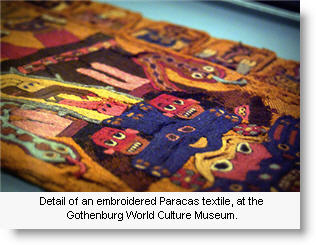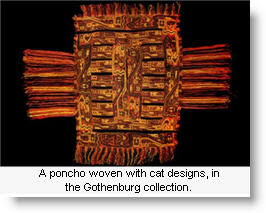President Alan Garcia announced Monday that Peru is to begin legal action against the city of Gothenburg in Sweden over the return of 100 items from the Paracas culture, state news agency Andina reported.
The announcement, made at a conference on international cooperation for the protection and repatriation of cultural heritage, came as a surprise to Gothenburg authorities who were already in good negotiations with Peruvian diplomats in Stockholm.
 Garcia, who will finish his term on July 28, said Gothenburg had been “complicit” in the removal of the textiles from Peru.
Garcia, who will finish his term on July 28, said Gothenburg had been “complicit” in the removal of the textiles from Peru.
“If [the city government] is indeed complicit in a robbery we have all the right to file criminal charges in Peru and use the Interpol to proceed with the capture of those that are complicit in the depreciation and looting of a country and civilization,” Garcia said.
“This comes as a total surprise to us, because we’ve had a good dialogue with Peru ever since they demanded we return the items in question,” Björn Sandmark, head of the Culture Administration in Gothenburg, said Tuesday.
Sandmark said he hoped legal action could be avoided, pointing out that the tone had been positive when he had met twice with Peru’s ambassador to Sweden (prior to the closing of Peru’s Embassy in Stockholm in July 2010) and, most recently in March 2011, with the new general consul, Lourdes Hilbck de Arróspide.
The city of Gothenburg’s culture administration had quickly recommended returning the objects to Peru, but the final decision lies with Gothenburg’s municipal council, which is not likely to handle the issue until after the summer holidays, according to Sandmark.
“These things often take time,” he explained, adding that he thought Peruvian authorities had understood and agreed with the process.
 According to Ambassador Liliana Cino, head of Cultural Affairs at the Ministry of Foreign Affairs, the president of the Gothenburg Cultural Committee, Helena Nyhus, said in 2010 that it was “a moral obligation to return the antiquities to their country of origin,” but that a city poll showed most citizens were against the return because they believed the transfer could cause “irreparable” damage to the fragile pieces. Cino also said that a change in museum authorities had been a problem.
According to Ambassador Liliana Cino, head of Cultural Affairs at the Ministry of Foreign Affairs, the president of the Gothenburg Cultural Committee, Helena Nyhus, said in 2010 that it was “a moral obligation to return the antiquities to their country of origin,” but that a city poll showed most citizens were against the return because they believed the transfer could cause “irreparable” damage to the fragile pieces. Cino also said that a change in museum authorities had been a problem.
The Paracas textiles in Gothenburg are some of the finest and most complex pieces known to exist from the ancient southern Peru civilization, besides one or two pieces in New York.
Following massive digging by grave robbers, Peruvian archaeologist Julio C. Tello – considered the founder of professional archaeology in Peru—led excavations of the Paracas peninsula in 1925 and discovered the sophisticated culture that had existed 2000 years earlier. Paracas textiles have always been high on the list of antiquities sought by smugglers and traders.
The City of Gothenburg has always recognized the provenance of the collection. According to the Gothenburg museum website, “large quantities of Paracas textiles were smuggled out of Peru and illegally exported to museums and private collections all over the world around 1930. About a hundred of them were smuggled to Sweden and donated to the Ethnographic Department of the Gothenburg Museum.”
In 2008, Gothenburg’s Museum of Culture launched a two-year exhibition of the textile collection as A Stolen World, recognizing the value of the pieces and the damage caused to nations by stripping them of their heritage and identity. Peruvian Embassy diplomats were especially invited to the exhibition.
And in May 2010, Sweden returned 33 pre-Columbian textile fragments to Peru.
President Garcia, perhaps riding on the wave of his government’s success to recover artifacts from Machu Picchu, said, “I think that we are going to be able to achieve, as in the case of Machu Picchu, that they return the 100 textiles.”
“I am sure that many countries that, with every right, negotiate, request, beg for the return of their goods that are essential and that will be held in museums… achieve the return to their countries,” he added.
In the case of Machu Picchu, however, Peru’s government had to wage a legal battle because Yale University would not return archaeological artifacts and pieces that had been taken on loan from Machu Picchu a century ago by American historian Hiram Bingham. Yale, and its Peabody Museum, refused to negotiate the return the pieces for many years, pieces that they had studied and restored and had on exhibition at the museum. Late last year, with pressure from members of the U.S. Congress and the White House, given the upcoming Machu Picchu centennial celebrations, the university finally relented and an agreement was reached to return the vast majority of the pieces and work jointly with Peru’s Ministry of Culture in a new museum and research center specifically made for the Machu Picchu collection in Cusco.
The first group of artifacts were returned earlier this year, and after being displayed a the Government Palace in Lima they were transported to Cusco where they are to be housed at the new museum in the Casa Concha owned by the San Antonio Abad University of Cusco.





